
- Classification
- Physical Education
- Travel and Tourism
- BIBLIOMETRICS
- Banking System
- Real Estate
Select Page

9 Pillars of Tourism
Posted by Md. Harun Ar Rashid | Oct 14, 2023 | Travel and Tourism
9 Pillars of Tourism:
The “9 Pillars of Tourism” represent the foundational components of the global tourism industry, each playing a vital role in shaping the experiences of travelers and the economic well-being of destinations. These pillars encompass a wide spectrum of services, attractions, and logistics that collectively define the tourism ecosystem. From accommodation and attractions that draw tourists in, to entertainment and events that enhance the visitor experience, the significance of each pillar is undeniable. In this article, we delve into the essence of these pillars, elucidating their individual roles and their collective impact on the thriving and dynamic world of tourism.
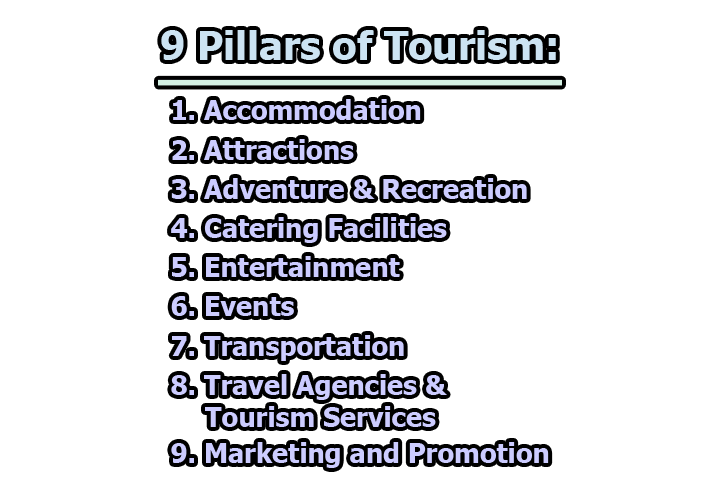
1. Accommodation:
Accommodation is one of the fundamental pillars of the tourism industry, as it addresses the essential need for travelers to find a comfortable place to rest, sleep, and relax during their journeys. The type and quality of accommodation options available in a destination can significantly impact the overall experience of tourists. Here’s a brief look at accommodation in the context of tourism:
1.1 Types of Accommodation:
- Hotels: Hotels are perhaps the most recognizable form of accommodation in the tourism industry. They come in a wide range of categories, from budget hotels and motels to luxury 5-star establishments. Hotels provide travelers with a comfortable and often standardized experience, offering amenities like room service, housekeeping, restaurants, and concierge services. They cater to various budget levels and preferences.
- Resorts: Resorts are typically larger properties situated in picturesque locations, often near beaches, mountains, or natural attractions. They offer not only accommodations but also a wide array of amenities and services, such as spa treatments, water sports, and entertainment. Resorts are known for their all-inclusive packages that provide guests with a comprehensive vacation experience.
- Hostels: Hostels are popular among budget travelers, particularly younger backpackers. They offer dormitory-style accommodations with shared facilities like bathrooms and kitchens. Hostels emphasize affordability, often with communal spaces where guests can socialize and exchange travel tips. Some hostels also offer private rooms for those seeking more privacy.
- Vacation Rentals: Vacation rentals include privately-owned homes, apartments, cabins, and cottages that travelers can rent for short-term stays. Platforms like Airbnb and Vrbo have made vacation rentals increasingly popular, as they allow tourists to experience a destination from a more local perspective. Vacation rentals often provide more space and amenities for longer stays.
- Campgrounds: For travelers who enjoy the outdoors, campgrounds offer a way to connect with nature. These can range from basic facilities with minimal amenities to well-equipped campgrounds with showers, electricity, and recreational areas. Campgrounds are especially popular among hikers, campers, and RV enthusiasts.
1.2 Significance: The significance of accommodation in the tourism industry cannot be overstated. It fulfills the basic need for shelter and comfort, making it possible for tourists to explore and enjoy destinations. Here are some key points illustrating its importance:
- Tourist Experience: The quality of accommodation can significantly influence a traveler’s overall experience. A comfortable and well-maintained place to stay enhances the enjoyment of the trip.
- Economic Impact: Accommodation facilities are a source of substantial revenue in the tourism sector. They create jobs, support local businesses, and contribute to the destination’s economic growth.
- Diversity and Inclusivity: Offering a variety of accommodation options ensures inclusivity in tourism, catering to travelers with different budgets, preferences, and travel styles. This diversity allows destinations to attract a broader range of tourists.
- Destination Attractiveness: The availability of high-quality accommodations is a key factor in a destination’s attractiveness. It can be a deciding factor for tourists when choosing their travel destinations.
2. Attractions:
Attractions are the primary motivators that draw travelers to specific destinations. They encompass a wide range of features, both natural and man-made, that capture the interest and curiosity of tourists. Here’s a closer look at the significance of attractions in tourism:
2.1 Types of Attractions:
- Natural Attractions: These include awe-inspiring natural wonders such as mountains, beaches, waterfalls, deserts, and national parks. The beauty and uniqueness of these sites often make them the centerpiece of a destination’s tourism industry.
- Cultural Attractions: Cultural landmarks, historical sites, museums, and heritage districts offer insights into a destination’s history, traditions, and art. These attractions help visitors connect with the local culture and heritage.
- Adventure Attractions: Some tourists seek thrilling experiences in the form of adventure activities like hiking, rock climbing, zip-lining, and water sports. Destinations with rugged landscapes and outdoor adventures often appeal to adventure enthusiasts.
- Entertainment Attractions: Theme parks, theaters, and live performances provide entertainment and amusement. Theme parks, in particular, are designed to offer a wide array of rides, shows, and themed experiences.
2.1 Significance: Attractions are the heart and soul of the tourism industry. They serve as the primary reasons people choose to travel and explore new places. Here are some key points highlighting their importance:
- Motivation to Travel: Attractions provide the motivation for travelers to visit a particular destination. The desire to see and experience these attractions is what drives tourism.
- Cultural Exchange: Cultural attractions allow tourists to engage with local traditions, art, and history. They promote cross-cultural understanding and appreciation.
- Economic Impact: Attractions often result in substantial visitor spending on entrance fees, guided tours, souvenirs, and local businesses, which, in turn, boost the local economy.
- Conservation and Preservation: The popularity of natural attractions often leads to conservation efforts to protect these sites. Cultural attractions can also contribute to the preservation of historical and architectural heritage.
3. Adventure & Recreation:
Adventure and recreation activities provide tourists with opportunities to engage in exciting and enjoyable experiences during their travels. These activities cater to a wide range of interests, allowing destinations to appeal to various types of travelers. Here’s an exploration of this pillar:
3.1 Types of Activities:
- Adventure Sports: These activities are designed to provide an adrenaline rush. Examples include whitewater rafting, rock climbing, skydiving, bungee jumping, and zip-lining. Adventure sports are particularly appealing to thrill-seekers.
- Outdoor Adventures: For nature enthusiasts, outdoor adventures like hiking, camping, biking, and wildlife safaris offer a chance to connect with the environment. These activities often take place in national parks, forests, and scenic landscapes.
- Wellness and Spa: Travelers looking for relaxation and rejuvenation often seek wellness and spa experiences. These can include massages, yoga retreats, hot springs, and wellness-focused retreats.
- Sports and Recreational Facilities: Destinations with golf courses, tennis courts, and sports facilities attract tourists interested in active recreation. Golf, in particular, is a sport that draws travelers to specific destinations.
3.1 Significance: Adventure and recreation activities contribute to the diversity of a destination’s tourism offerings, making it more appealing to a broad range of travelers. Here’s why this pillar is essential:
- Diverse Appeal: Adventure and recreation activities cater to a wide spectrum of tourists, from adventure enthusiasts and nature lovers to wellness seekers and sports enthusiasts.
- Length of Stay: Engaging activities often encourage longer stays in a destination. Travelers may spend more time exploring and participating in recreational pursuits.
- Destination Differentiation: Adventure and recreation options can set a destination apart from its competitors. Unique activities create a compelling reason for tourists to choose one location over another.
- Local Engagement: These activities often involve interactions with local guides and service providers, which can promote cultural exchange and support local businesses.
4. Catering Facilities:
Catering facilities play a significant role in the tourism industry as they encompass a wide range of dining establishments and food-related services. Travelers often seek to experience the local cuisine and taste new flavors, making catering facilities an essential aspect of the overall tourism experience.
4.1 Types of Catering Facilities:
- Restaurants: Restaurants come in various forms, from fine dining establishments to casual eateries. They offer a diverse menu, including local and international cuisine, allowing tourists to explore the culinary traditions of the destination.
- Street Food: Street food vendors and markets offer a unique way for travelers to sample authentic local flavors. This is a particularly popular option among those seeking an immersive food experience.
- Cafes and Coffee Shops: Cafes provide a cozy and relaxed setting for travelers to enjoy a cup of coffee, light snacks, or pastries. They are ideal for casual dining and coffee breaks.
- Fine Dining: Fine dining restaurants offer gourmet cuisine and often feature upscale ambiance and service. They cater to tourists looking for a high-end dining experience.
4.2 Significance: The significance of catering facilities in the tourism industry goes beyond mere sustenance; it plays a vital role in enhancing the overall tourism experience:
- Cultural Exploration: Dining at local restaurants and trying street food allows tourists to immerse themselves in the culture and culinary traditions of the destination.
- Economic Contribution: Catering facilities generate revenue and employment opportunities, supporting the local economy and food industry.
- Diverse Options: A variety of catering facilities ensures that tourists with different tastes and preferences are well-catered to, enhancing the overall appeal of the destination.
- Tourist Satisfaction: Access to high-quality dining options contributes to visitor satisfaction and can lead to positive reviews and return visits.
5. Entertainment:
Entertainment facilities are crucial for enhancing the overall tourist experience. These facilities include theaters, cinemas, music venues, and other sources of entertainment that tourists often seek in the evenings or during leisure time.
5.1 Types of Entertainment Facilities:
- Theaters and Concert Halls: These venues host live performances, including plays, musicals, concerts, and other cultural events. They provide opportunities for tourists to enjoy the performing arts.
- Cinemas: Cinemas screen movies, including local and international films. For travelers, catching a film can be a leisurely way to spend an evening or a rainy day.
- Nightclubs and Bars: Nightlife is a significant attraction for many tourists. Nightclubs and bars offer entertainment, music, and dancing, making them popular choices for those seeking lively social experiences.
- Cultural Shows: In destinations rich in cultural traditions, tourists can attend cultural shows that feature traditional dance performances, music, and local art displays.
5.2 Significance: Entertainment facilities contribute to the overall enjoyment of a destination and offer tourists diverse options for leisure and cultural enrichment. Here are some reasons why entertainment is important in tourism:
- Leisure and Relaxation: After a day of exploring, tourists often seek entertainment facilities to unwind, socialize, and have fun.
- Cultural Exchange: Cultural shows and live performances allow tourists to engage with local traditions and artistic expressions.
- Economic Impact: Entertainment facilities contribute to the local economy by generating revenue from ticket sales, food and beverage services, and merchandise.
- Nightlife and Social Interaction: Nightclubs and bars are essential for the vibrant nightlife that many tourists look for in a destination. They promote social interactions and contribute to the city’s atmosphere.
Events represent a diverse range of gatherings that attract a substantial number of visitors to a destination. These occasions can be cultural festivals, sporting events, conferences, or seasonal celebrations, and they often play a significant role in shaping a destination’s identity.
6.1 Types of Events:
- Cultural Festivals: Cultural festivals celebrate a destination’s unique traditions, music, art, and cuisine. They often showcase the local culture and heritage, providing tourists with an immersive experience.
- Sporting Events: Sporting events draw sports enthusiasts and fans to a destination. Whether it’s a major tournament or a local competition, sports events can lead to a surge in tourism.
- Conferences and Expos: Professional conferences, trade shows, and expos bring industry experts and business travelers to a destination. These events can have a considerable impact on the local economy.
- Seasonal Celebrations: Seasonal events, including holiday festivals, parades, and special celebrations, create a sense of festivity and can attract tourists during specific times of the year.
6.2 Significance: Events have a substantial impact on tourism and the local community. Here’s why events are an essential pillar of tourism:
- Tourism Peaks: Events often result in surges in visitation, boosting the local tourism industry, accommodation bookings, and the demand for catering and entertainment services.
- Economic Boost: Events can stimulate the local economy by generating revenue from ticket sales, merchandise, and associated businesses, such as restaurants and shops.
- Community Engagement: Events encourage community participation and contribute to the cultural vibrancy of the destination.
- Identity and Promotion: Events can help shape a destination’s identity and provide opportunities for promotion, attracting tourists and media attention.
7. Transportation:
Efficient transportation systems are the lifeblood of the tourism industry, as they are responsible for ensuring that tourists can reach their chosen destinations conveniently and safely. Transportation encompasses various modes of travel, including air, road, rail, and maritime transport.
7.1 Types of Transportation:
- Air Travel: Airlines play a central role in connecting destinations, both domestically and internationally. Airports serve as gateways for travelers, offering a wide range of flights and routes to various destinations.
- Road Networks: Efficient road networks, including highways and well-maintained roads, provide tourists with the flexibility to explore a destination by car, bus, or other ground transportation options.
- Railways: Trains and metro systems are vital for urban transportation and connecting different regions within a country. Trains can offer scenic journeys and a unique way to experience a destination.
- Maritime Transport: For destinations near the coast or with accessible waterways, maritime transport includes ferries, cruise ships, and boats that provide an alternative and scenic means of travel.
7.2 Significance: Transportation is a crucial pillar of tourism for several reasons:
- Accessibility: Efficient transportation systems make it possible for tourists to access and explore a wide range of destinations, boosting visitation and tourism revenue.
- Connectivity: Reliable transportation links enable tourists to move seamlessly between regions, cities, and attractions, enhancing the overall tourist experience.
- Economic Impact: The transportation sector contributes to the local economy through employment, infrastructure development, and the support of related businesses such as hotels, restaurants, and car rentals.
- Logistics and Convenience: Tourism transportation services provide convenience and ensure that travelers can access services such as airport transfers, car rentals, and guided tours.
8. Travel Agencies & Tourism Services:
Travel agencies and tourism services play a pivotal role in facilitating tourists’ journeys by providing a range of essential services, including travel planning, booking, and support during trips. They ensure that travelers have a seamless and enjoyable experience.
8.1 Types of Tourism Services:
- Travel Agencies: Travel agencies assist travelers in planning their trips, booking accommodations, transportation, and tours, and providing expert advice on destinations and travel regulations.
- Tour Operators: Tour operators offer packaged tours and experiences, often with specific itineraries, activities, and group travel options, making travel planning more accessible for tourists.
- Travel Insurance: Travel insurance providers offer coverage for unexpected events during trips, such as trip cancellations, medical emergencies, and lost luggage, giving tourists peace of mind.
- Visa and Passport Services: These services assist travelers with obtaining the necessary travel documentation, including visas, passports, and permits, ensuring smooth international travel.
8.2 Significance: Travel agencies and tourism services are integral to the tourism industry for the following reasons:
- Travel Convenience: These services simplify the travel planning process, saving tourists time and effort in arranging various aspects of their trips.
- Expert Guidance: Travel agencies and tour operators provide valuable insights into destinations, helping travelers make informed decisions about their journeys.
- Risk Mitigation: Travel insurance protects tourists from unforeseen events and provides financial security during their trips.
- Documentation Assistance: Visa and passport services ensure that travelers have the necessary documents for international travel, reducing potential hurdles and complications.
9. Marketing and Promotion:
While not always explicitly mentioned as one of the “pillars,” marketing and promotion are critical components of the tourism industry. Effective marketing strategies are essential for attracting and retaining tourists. Marketing includes destination promotion, online presence, and branding efforts to engage potential travelers.
9.1 Marketing Strategies:
- Digital Marketing: Utilizing websites, social media, and online advertising to reach a wide audience of potential tourists and inspire travel interest.
- Destination Promotion: Showcasing the unique features, attractions, and experiences a destination offers through brochures, websites, and multimedia campaigns.
- Collaborations and Partnerships: Collaborating with airlines, hotels, and other businesses to create attractive packages, discounts, and special offers.
- Tourism Campaigns: Launching marketing campaigns to promote special events, seasonal attractions, or unique aspects of the destination.
9.2 Significance: Marketing and promotion efforts play a critical role in the success of the tourism industry:
- Awareness and Interest: Effective marketing efforts create awareness and generate interest in a destination, enticing travelers to consider visiting.
- Visitor Flow: Marketing can help distribute tourists more evenly throughout the year by promoting specific events or attractions during off-peak seasons.
- Economic Growth: Increased visitation resulting from successful marketing campaigns leads to higher revenue for the tourism sector, local businesses, and the destination as a whole.
- Competitive Edge: In a competitive market, effective marketing can set a destination apart from its competitors, making it a more attractive choice for travelers.
In conclusion , the “9 Pillars of Tourism” are not mere isolated elements but intricately woven threads that constitute the fabric of the tourism industry. Accommodation ensures travelers find comfort and rest, attractions serve as magnets drawing tourists, and adventure and recreation cater to diverse interests. Catering facilities offer a taste of local culture, while entertainment keeps tourists engaged after hours. Events create tourism peaks, transportation links it all, travel agencies provide support, and marketing and promotion weave a compelling narrative. Understanding the significance of each pillar and their symbiotic relationships is essential for stakeholders to create memorable, vibrant, and sustainable tourism experiences for all. These pillars collectively support the ever-evolving tourism industry, which continues to captivate the imagination of travelers worldwide.

Former Student at Rajshahi University
About The Author

Md. Harun Ar Rashid
Related posts.
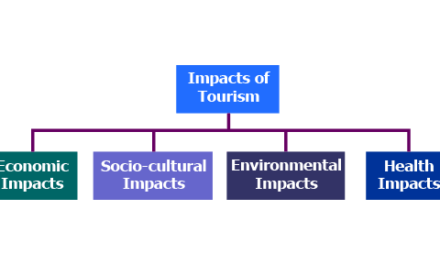
Tourism | Forms and Impacts of Tourism
April 13, 2023
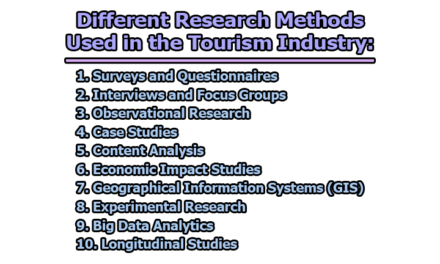
Different Research Methods Used in the Tourism Industry
February 23, 2024
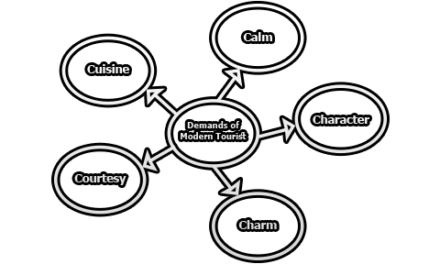
Demands of Modern Tourist
April 18, 2023

Process of Allocating and Prioritizing Your Tour Budget
November 4, 2023
Follow us on Facebook
Library & Information Management Community
Recent Posts
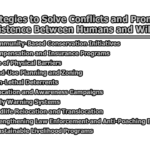
Pin It on Pinterest
- LiveJournal

What Are the 9 Sectors of Tourism?
By Michael Ferguson
Tourism is a massive industry that encompasses a wide range of sectors. These sectors are the backbone of the tourism industry as they provide the necessary infrastructure, services, and facilities that make tourism possible. In this article, we will explore the nine sectors of tourism and their crucial roles in shaping the tourism industry.
1. Accommodation Sector
The accommodation sector includes hotels, resorts, motels, hostels, and other types of lodging facilities. This sector plays a crucial role in providing comfortable and safe accommodations for tourists during their stay. The accommodation sector is responsible for providing clean rooms, comfortable beds, essential amenities such as towels and toiletries, and excellent customer service.
2. Food and Beverage Sector
The food and beverage sector includes restaurants, cafes, bars, pubs, food trucks, and other dining establishments. This sector provides tourists with a variety of food options to choose from during their travels. The food and beverage sector also plays a crucial role in promoting local cuisine and culture.
3. Transportation Sector
The transportation sector includes airlines, trains, buses, taxis, rental cars, and other modes of transportation. This sector provides tourists with convenient ways to travel between destinations. The transportation sector is responsible for ensuring that tourists reach their destination safely and comfortably.
4. Travel Trade Sector
The travel trade sector includes tour operators, travel agents, travel wholesalers who package tours for sale to retailers or directly to consumers. They assist travelers in planning their trips by providing them with information on destinations such as accommodations available or things to do while visiting an area.
5. Adventure Tourism Sector
The adventure tourism sector includes activities such as hiking trails/mountainsides/climbing sites/waterfalls/rafting/camping/safari/bungee jumping/parasailing/skydiving etc. This sector caters to tourists who seek adventurous and thrilling experiences during their travels.
6. Events and Conferences Sector
The events and conferences sector includes concerts, festivals, conferences, and other public events. This sector plays a vital role in promoting destinations by hosting various events that attract tourists from all over the world.
7. Tourism Services Sector
The tourism services sector includes services such as tour guides, translators, travel insurance providers, photographers, and other services that are essential to the tourism industry. These services make traveling easier for tourists by providing them with necessary information and assistance.
8. Attractions Sector
The attractions sector includes museums, galleries, amusement parks, zoos, aquariums, gardens, historical sites & buildings etc. This sector provides tourists with engaging and enriching experiences that showcase local culture and history.
9. Tourism Infrastructure Sector
The tourism infrastructure sector includes facilities such as airports, ports/marinas/harbours/train stations/bus terminals/tourist centres/public restrooms/ATMs/parking lots/roads/highways/bridges etc. This sector provides essential services that support the smooth functioning of the tourism industry.
In Conclusion,
These nine sectors of tourism work together to create a dynamic industry that caters to the needs of travelers worldwide. Understanding these sectors is crucial for anyone looking to start a career in the tourism industry or planning a trip themselves. We hope this article has provided valuable insights into the role each sector plays in shaping the tourism industry.
9 Related Question Answers Found
What are the sectors of tourism, what are the different sectors of tourism, what are the main sectors of tourism, what are the five sectors of tourism, what are the 5 main sectors of tourism, what are the 8 sectors of tourism, what are the main sectors of tourism industry, what are the 5 sectors of tourism, what are the 4 sectors of tourism, backpacking - budget travel - business travel - cruise ship - vacation - tourism - resort - cruise - road trip - destination wedding - tourist destination - best places, london - madrid - paris - prague - dubai - barcelona - rome.
© 2024 LuxuryTraveldiva
UN Tourism | Bringing the world closer
Share this content.
- Share this article on facebook
- Share this article on twitter
- Share this article on linkedin
Tourism in the 2030 Agenda
The year 2015 has been a milestone for global development as governments have adopted the 2030 Agenda for Sustainable Development, along with the Sustainable Development Goals (SDGs). The bold agenda sets out a global framework to end extreme poverty, fight inequality and injustice, and fix climate change until 2030. Building on the historic Millennium Development Goals (MDGs), the ambitious set of 17 Sustainable Development Goals and 169 associated targets is people-centred, transformative, universal and integrated.

Harnessing tourism's benefits will be critical to achieving the sustainable development goals and implementing the post-2015 development agenda
Tourism has the potential to contribute, directly or indirectly, to all of the goals. In particular, it has been included as targets in Goals 8, 12 and 14 on inclusive and sustainable economic growth, sustainable consumption and production (SCP) and the sustainable use of oceans and marine resources, respectively.
Sustainable tourism is firmly positioned in the 2030 Agenda. Achieving this agenda, however, requires a clear implementation framework, adequate financing and investment in technology, infrastructure and human resources.


GOAL 1: NO POVERTY

GOAL 2: ZERO HUNGER

GOAL 3: GOOD HEALTH AND WELL-BEING

GOAL 4: QUALITY EDUCATION

GOAL 5: GENDER EQUALITY

GOAL 6: CLEAN WATER AND SANITATION

GOAL 7: AFFORDABLE AND CLEAN ENERGY

GOAL 8: DECENT WORK AND ECONOMIC GROWTH

GOAL 9: INDUSTRY, INNOVATION AND INFRASTRUCTURE

GOAL 10: REDUCED INEQUALITIES

GOAL 11: SUSTAINABLE CITIES AND COMMUNITIES
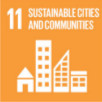
GOAL 12: RESPONSIBLE CONSUMPTION AND PRODUCTION

GOAL 13: CLIMATE ACTION

GOAL 14: LIFE BELOW WATER
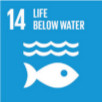
GOAL 15: LIFE ON LAND

GOAL 16: PEACE AND JUSTICE

GOAL 17: PARTNERSHIPS FOR THE GOALS

- Understanding Poverty
- Competitiveness
Tourism and Competitiveness
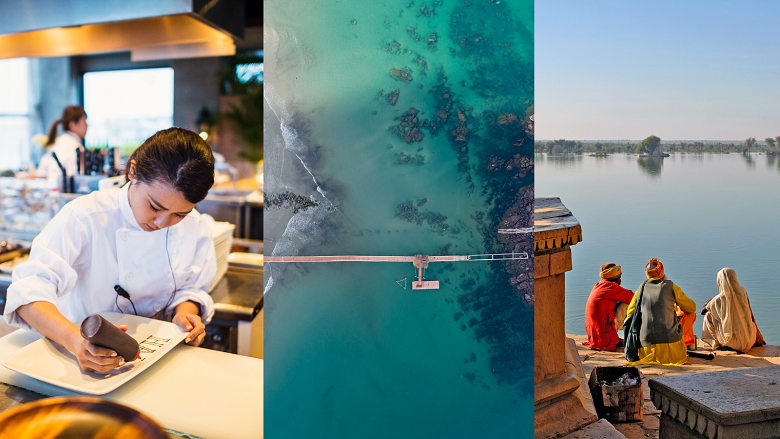
- Publications
The tourism sector provides opportunities for developing countries to create productive and inclusive jobs, grow innovative firms, finance the conservation of natural and cultural assets, and increase economic empowerment, especially for women, who comprise the majority of the tourism sector’s workforce. Before the COVID-19 pandemic, tourism was the world’s largest service sector—providing one in ten jobs worldwide, almost seven percent of all international trade and 25 percent of the world’s service exports —a critical foreign exchange generator. In 2019 the sector was valued at more than US$9 trillion and accounted for 10.4 percent of global GDP.
Tourism offers opportunities for economic diversification and market-creation. When effectively managed, its deep local value chains can expand demand for existing and new products and services that directly and positively impact the poor and rural/isolated communities. The sector can also be a force for biodiversity conservation, heritage protection, and climate-friendly livelihoods, making up a key pillar of the blue/green economy. This potential is also associated with social and environmental risks, which need to be managed and mitigated to maximize the sector’s net-positive benefits.
The impact of the COVID-19 pandemic has been devastating for tourism service providers, with a loss of 20 percent of all tourism jobs (62 million), and US$1.3 trillion in export revenue, leading to a reduction of 50 percent of its contribution to GDP in 2020 alone. The collapse of demand has severely impacted the livelihoods of tourism-dependent communities, small businesses and women-run enterprises. It has also reduced government tax revenues and constrained the availability of resources for destination management and site conservation.
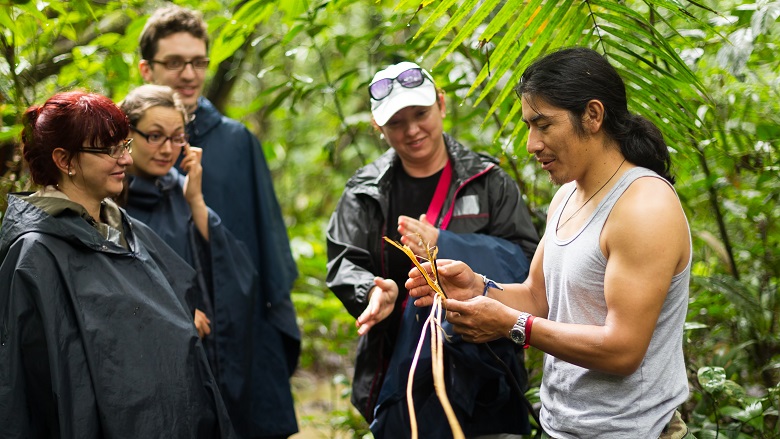
Naturalist local guide with group of tourist in Cuyabeno Wildlife Reserve Ecuador. Photo: Ammit Jack/Shutterstock
Tourism and Competitiveness Strategic Pillars
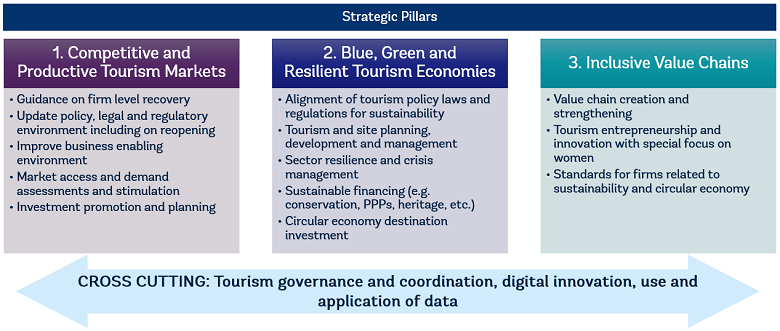
Our solutions are integrated across the following areas:
- Competitive and Productive Tourism Markets. We work with government and private sector stakeholders to foster competitive tourism markets that create productive jobs, improve visitor expenditure and impact, and are supportive of high-growth, innovative firms. To do so we offer guidance on firm and destination level recovery, policy and regulatory reforms, demand diversification, investment promotion and market access.
- Blue, Green and Resilient Tourism Economies. We support economic diversification to sustain natural capital and tourism assets, prepare for external and climate-related shocks, and be sustainably managed through strong policy, coordination, and governance improvements. To do so we offer support to align the tourism enabling and policy environment towards sustainability, while improving tourism destination and site planning, development, and management. We work with governments to enhance the sector’s resilience and to foster the development of innovative sustainable financing instruments.
- Inclusive Value Chains. We work with client governments and intermediaries to support Small and Medium sized Enterprises (SMEs), and strengthen value chains that provide equitable livelihoods for communities, women, youth, minorities, and local businesses.
The successful design and implementation of reforms in the tourism space requires the combined effort of diverse line ministries and agencies, and an understanding of the impact of digital technologies in the industry. Accordingly, our teams support cross-cutting issues of tourism governance and coordination, digital innovation and the use and application of data throughout the three focus areas of work.
Tourism and Competitiveness Theory of Change
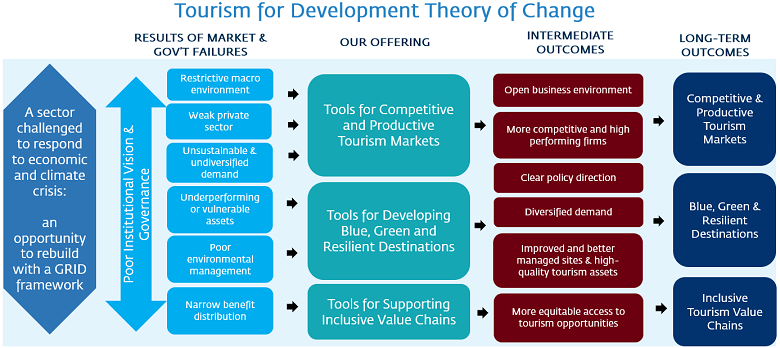
Examples of our projects:
- In Indonesia , a US$955m loan is supporting the Government’s Integrated Infrastructure Development for National Tourism Strategic Areas Project. This project is designed to improve the quality of, and access to, tourism-relevant basic infrastructure and services, strengthen local economy linkages to tourism, and attract private investment in selected tourism destinations. In its initial phases, the project has supported detailed market and demand analyses needed to justify significant public investment, mobilized integrated tourism destination masterplans for each new destination and established essential coordination mechanisms at the national level and at all seventeen of the Project’s participating districts and cities.
- In Madagascar , a series of projects totaling US$450m in lending and IFC Technical Assistance have contributed to the sustainable growth of the tourism sector by enhancing access to enabling infrastructure and services in target regions. Activities under the project focused on providing support to SMEs, capacity building to institutions, and promoting investment and enabling environment reforms. They resulted in the creation of more than 10,000 jobs and the registration of more than 30,000 businesses. As a result of COVID-19, the project provided emergency support both to government institutions (i.e., Ministry of Tourism) and other organizations such as the National Tourism Promotion Board to plan, strategize and implement initiatives to address effects of the pandemic and support the sector’s gradual relaunch, as well as to directly support tourism companies and workers groups most affected by the crisis.
- In Sierra Leone , an Economic Diversification Project has a strong focus on sustainable tourism development. The project is contributing significantly to the COVID-19 recovery, with its focus on the creation of six new tourism destinations, attracting new private investment, and building the capacity of government ministries to successfully manage and market their tourism assets. This project aims to contribute to the development of more circular economy tourism business models, and support the growth of women- run tourism businesses.
- Through the Rebuilding Tourism Competitiveness: Tourism Response, Recovery and Resilience to the COVID-19 Crisis initiative and the Tourism for Development Learning Series , we held webinars, published insights and guidance notes as well as formed new partnerships with Organization of Eastern Caribbean States, United Nations Environment Program, United Nations World Tourism Organization, and World Travel and Tourism Council to exchange knowledge on managing tourism throughout the pandemic, planning for recovery and building back better. The initiative’s key Policy Note has been downloaded more than 20,000 times and has been used to inform recovery initiatives in over 30 countries across 6 regions.
- The Global Aviation Dashboard is a platform that visualizes real-time changes in global flight movements, allowing users to generate 2D & 3D visualizations, charts, graphs, and tables; and ranking animations for: flight volume, seat volume, and available seat kilometers. Data is available for domestic, intra-regional, and inter-regional routes across all regions, countries, airports, and airlines on a daily, weekly, or monthly basis from January 2020 until today. The dashboard has been used to track the status and recovery of global travel and inform policy and operational actions.
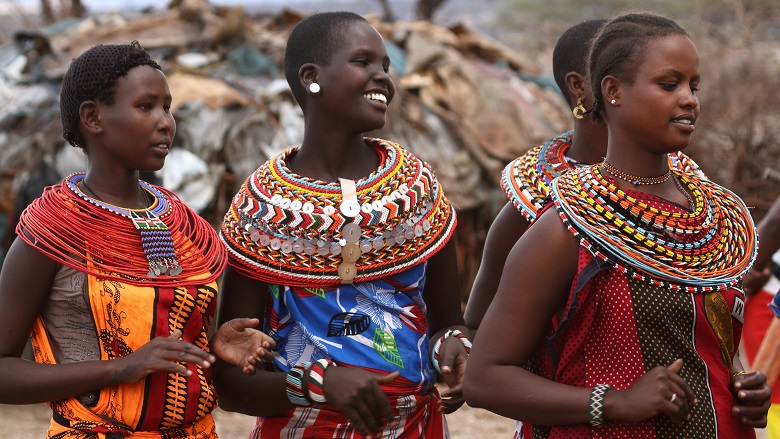
Traditional Samburu women in Kenya. Photo: hecke61/Shutterstock.
Featured Data
We-Fi WeTour Women in Tourism Enterprise Surveys (2019)
- Sierra Leone | Ghana
Featured Reports
- Destination Management Handbook: A Guide to the Planning and Implementation of Destination Management (2023)
- Blue Tourism in Islands and Small Tourism-Dependent Coastal States : Tools and Recovery Strategies (2022)
- Resilient Tourism: Competitiveness in the Face of Disasters (2020)
- Tourism and the Sharing Economy: Policy and Potential of Sustainable Peer-to-Peer Accommodation (2018)
- Supporting Sustainable Livelihoods through Wildlife Tourism (2018)
- The Voice of Travelers: Leveraging User-Generated Content for Tourism Development (2018)
- Women and Tourism: Designing for Inclusion (2017)
- Twenty Reasons Sustainable Tourism Counts for Development (2017)
- An introduction to tourism concessioning:14 characteristics of successful programs. The World Bank, 2016)
- Getting financed: 9 tips for community joint ventures in tourism . World Wildlife Fund (WWF) and World Bank, (2015)
- Global investment promotion best practices: Winning tourism investment” Investment Climate (2013)
Country-Specific
- COVID-19 and Tourism in South Asia: Opportunities for Sustainable Regional Outcomes (2020)
- Demand Analysis for Tourism in African Local Communities (2018)
- Tourism in Africa: Harnessing Tourism for Growth and Improved Livelihoods . Africa Development Forum (2014)
COVID-19 Response
- Expecting the Unexpected : Tools and Policy Considerations to Support the Recovery and Resilience of the Tourism Sector (2022)
- Rebuilding Tourism Competitiveness. Tourism response, recovery and resilience to the COVID-19 crisis (2020)
- COVID-19 and Tourism in South Asia Opportunities for Sustainable Regional Outcomes (2020)
- WBG support for tourism clients and destinations during the COVID-19 crisis (2020)
- Tourism for Development: Tourism Diagnostic Toolkit (2019)
- Tourism Theory of Change (2018)
Country -Specific
- COVID Impact Mitigation Survey Results (South Africa) (2020)
- COVID Preparedness for Reopening Survey Results (South Africa) (2020)
- COVID Study (Fiji) (2020) with IFC
Featured Blogs
- Louise Twining-Ward and Alba Suris , Bridging the Tourism Data Divide: New Tools for Policymaking
- Fiona Stewart, Samantha Power & Shaun Mann , Harnessing the power of capital markets to conserve and restore global biodiversity through “Natural Asset Companies” | October 12 th 2021
- Mari Elka Pangestu , Tourism in the post-COVID world: Three steps to build better forward | April 30 th 2021
- Hartwig Schafer , Regional collaboration can help South Asian nations rebuild and strengthen tourism industry | July 23 rd 2020
- Caroline Freund , We can’t travel, but we can take measures to preserve jobs in the tourism industry | March 20 th 2020
Featured Webinars
- Destination Management for Resilient Growth . This webinar looks at emerging destinations at the local level to examine the opportunities, examples, and best tools available. Destination Management Handbook
- Launch of the Future of Pacific Tourism. This webinar goes through the results of the new Future of Pacific Tourism report. It was launched by FCI Regional and Global Managers with Discussants from the Asian Development Bank and Intrepid Group.
- Circular Economy and Tourism . This webinar discusses how new and circular business models are needed to change the way tourism operates and enable businesses and destinations to be sustainable.
- Closing the Gap: Gender in Projects and Analytics . The purpose of this webinar is to raise awareness on integrating gender considerations into projects and provide guidelines for future project design in various sectoral areas.
- WTO Tourism Resilience: Building forward Better. High-level panelists from Sri Lanka, Costa Rica, Jordan and Kenya discuss how donors, governments and the private sector can work together most effectively to rebuild the tourism industry and improve its resilience for the future.
- Tourism Watch
- Tourism Factsheets
- [email protected]
Launch of Blue Tourism Resource Portal

Components of tourism: Structure of the tourism industry
The travel and tourism industry is argued by many as being the largest industry in the world. It is, therefore, no surprise that the structure of the tourism industry is quite complex, involving many components of tourism.
With many different types of tourism and types of businesses operating within the tourism industry, from private companies to charities and NGOs, the structure of the tourism industry is made up of many different segments and components.
In this article I will provide you with an overview of the structure of the tourism industry, outlining the types of organisations and stakeholders in tourism that are involved.
Structure of the tourism industry
Components of tourism, international organisations, national tourist boards, regional tourist boards, tourist information centres, travel by air, travel by road, travel by train, travel by water, hotels chains, hostels and budget accommodation, holiday parks and campsites, accommodation innovations, world travel market, football world cup, glastonbury, holi festival, day of the dead, natural attractions, built attractions, tour operators, travel agents, ancillary services, components of tourism | structure of the tourism industry, structure of the tourism industry | components of tourism: further reading.
The importance of tourism is demonstrated when you can see how big the industry is!
The structure of the industry is made up of several components of tourism and involves many different stakeholders. These components are all interrelated in one way of another. The components of tourism make up the entire tourism system.

There are several integral components of tourism. Without these components, the tourism industry would struggle to function. I have explained what this means below, but before you read on, take a look at this short video that I made (and if you like what you see, don’t forget to subscribe to my YouTube channel)!
This was demonstrated, for example, during the Coronavirus pandemic, which halted air travel around the world. Travel services are a vital component of tourism and without these services being operational, the tourism industry struggled to survive!
There are six major components of tourism, each with their own sub-components. These are: tourist boards, travel services, accommodation services, conferences and events, attractions and tourism services.

Below, I will explain what each of the components offer to the tourism industry and provide some relevant examples.
Components of tourism: Tourist boards
A tourist board is an essential component of tourism and an integral part of the structure of the tourism industry.
A tourism board is responsible for the promotion of tourism in a particular area. This could be a city, a region, a country or a group of countries.
A tourism board is usually Government funded and is usually a public travel and tourism organisation (although this is not always the case).
A tourism board is also often referred to as a Destination Marketing Organisation (DMO).
Most tourist boards focus on promoting tourism in a particular area, city or country. There are, however, some organisations which aim to promote tourism across more than one country.
Whilst these organisation often have many functions other than tourism, they will also play a role in the promotion of tourism in particular parts of the world. This could include the European Union , the ASEAN network or organisations such as the United Nations.
A national tourist board is a national organisation whose aim is to promote tourism across the country.
There are usually several management bodies that are involved with a national tourist board. They are essential stakeholders who determine many aspects of tourism in the country, such as budgets, taxation and regulations.
Said management bodies include the parliament, the tourist board, an auditing committee and the Prime Minister, President or Head of State.
The national tourist board is funded from tourist taxes, membership fees, Government funding and other sources.
Examples of national tourist boards (often most commonly referred to by their ‘campaign title’ as opposed to the Government title) include Visit Britain , Incredible India and Amazing Thailand .
A regional tourist board is a tourist board that focusses on a particular region of a country. They are often a sub-division of a country’s national tourist board.
Regional tourism boards are often funded and operated in the same way as national tourist boards.
Examples of successful regional tourism boards include: Visit Cornwall in the UK, Kerala Tourism in India, Visite Montreal in Canada and Cape Town Tourism in South Africa.
A tourist information centre is the place where tourists can go for advice and help with regards to all matters related to tourism in the area.
In the tourist information centre (TIC) you will find staff who are knowledgeable about the local area. There will often be a range of printed and digital information for you, including leaflets, maps, coupons and guidebooks. Sometimes there will be virtual tourism facilities.
Tourist information centres have been an important component of tourism throughout the history of travel and tourism , however, they are coming under increasing pressure as a result of information that is available online. This has resulted in fewer people visiting TICs in person.
Most major tourist areas will have a tourist information centre. These are usually centrally located.
Tourist information centres are funded by the local Government.
Other posts that you might be interested in: – What is tourism? A definition of tourism – The history of tourism – Stakeholders in tourism – Dark tourism explained – What is ABTA and how does it work? – The economic impacts of tourism
Components of tourism:Transport services
The relationship between transport and tourism is strong.
According to the most commonly accepted definitions of tourism, a person must travel away from their home environment for at least one night in order to be a tourist (although I would argue that this definition needs updating given that it doesn’t account for novel forms of tourism such as a staycation or virtual tourism ).
Based on this fact, therefore, transport is an integral component of tourism. Without transport, people cannot reach their intended destination.
There are a range of different transport types. The most common and popular methods of transport that make up the structure of the tourism industry, however, are: air, road, train and water .

Travel by air has grown exponentially in the past few decades. With the introduction of low cost airlines and deregulation, the competitive market has been a tourist’s paradise.
New routes opening up has introduced tourists to areas that they may never have been able to reach before and low prices have resulted in more of us taking more trips abroad using air travel as our means of transportation.
Travel by air is an essential component of tourism and this was demonstrated during the Coronavirus epidemic. During this time most air traffic was halted, which had a devastating impact of the tourism industry world-wide.
Travel by road is also a core component of tourism, particularly for domestic tourism .
Travel by road is more popular in some countries than others. This largely depends on accessibility options (i.e. what is accessible by road), distances required and road conditions.
In destinations where travel by road is popular, there are often many car hire or rental companies.
Travel by train is very popular in destinations that have good rail networks in infrastructure.
In some parts of the world, such as China and Japan, there are world-class high-speed railways that can be more efficient than flying.
In other parts of the world, the rail journey is part of the tourism experience. A good example of this is the Siberian Railway.
In Europe you can buy an affordable interrail pass , which allows you to travel throughout Europe using the rail system.

Travel by water is also an important component of tourism.
The structure of the tourism industry includes cruises, ferries and leisure boats, among other types of travel by water.
Travel by water can vary considerably in price and can include anything from a round the world cruise to a short long tail ride in Thailand .
Components of tourism: Accommodation services
Accommodation services make up an important part of the structure of the tourism industry.
Whilst accommodation services were traditionally focussed mainly around the hotel industry, nowadays accommodation options for tourists are much more varied. This adds an additional layer of complexity to the structure of the tourism industry.
There are many hotel chains that operate throughout the tourism industry and that are a key component of tourism.
Multinational corporations have expanded throughout the tourism industry with key players being hotel chains such as Marriott, Radisson, Hilton, Travel Lodge and Holiday Inn.
However, hotel chains such as these have come under increased scrutiny as a result of the economic leakage in tourism that they cause.
Hostels and budget accommodation options are popular with budget travellers and backpackers.
There are a range of hostels found throughout the world. These are particularly popular in destinations where accommodation is expensive, such as London, New York and Singapore.
The Youth Hostel Association (YHA) and Hostelling International are popular hostel providers that are found across the UK and overseas.
Billy Butlin changed the face of the British holiday market with the introduction of his seaside holiday parks back in 1936.
Since this time, other similar chains have expanded throughout the UK and the rest of the world.
Camping is also an important component of tourism. There are camp sites situated throughout the world ranging from safari camps to glamping (glamorous camping).
Homestays have become an increasingly prominent component of tourism.
Whilst bed and breakfast accommodation has been around for a very long time, nowadays there are many more options that are grounded on the concept of a homestay.
The sharing economy has seen the growth and introduction of many types of accommodations into the travel and tourism sector that did not exist before.
The most popular of these is Airbnb, where people rent out a room or an entire property to tourists. You can read more about how Airbnb works here .
In recent years consumers have been demanding new and unusual experiences more than ever. In response to this, we have seen many accommodation innovations emerge throughout the world.
From staying in an ice hotel in Finland, to sleeping in a hammock in Borneo to a night in a haunted castle in Wales, there are many different types of accommodation options that can make your holiday a little bit more exciting!
Components of tourism: Conferences and events
Conferences and events make up a significant part of the structure of the tourism industry.
Conferences, which often come under business tourism , come in all shapes and sizes around the world.
From a small academic gathering to a large-scale summit involving national leaders from around the world, conferences are an important component of tourism.
Likewise, the event sector is also a significant part of the tourism industry.
There are millions of events that take place around the world each year that vary in size and function. Many of these form an integral part of the tourism industry.
Examples of major conferences and events around the world
There are many major conferences and events that take place around the world every year. Here are a few of my favourites:
The World Travel Market (WTM) is held in London each November. This is a large event that is held at the Excel venue.
WTM provides travel industry experts with the opportunity to showcase their work, learn more about the industry and to network.
ITB is the world’s leading international travel trade show. It is held in Berlin each year.
Similar to the WTM, this large-scale event enables industry professionals to network and undertake continuous professional development.
The vast majority of people are familiar with the Football World Cup.
The Football World Cup is held every four years in a different location.
The Football World Cup attracts millions of tourists from all over the world. The event also acts as a stimuli for tourism as the nation will often use the opportunity of hosting the event as a chance to market tourism in the area to those who are tuning in from their TVs from around the world.
Sports tourism , which includes events such as the Football World Cup, contributes significantly to the overall tourism industry.
Glastonbury is a popular British music festival. It takes place each summer in Somerset.
Glastonbury is a five-day festival of contemporary performing arts. In addition to music, the festival hosts dance, comedy, theatre, circus, cabaret, and other arts to entertain visitors.
Glastonbury attracts many domestic tourists as well as international tourists.
San Fermin is a festival that is held in Pamplona, Spain each July.
San Fermin, also known as the ‘Running of the Bulls’ is a historically-rooted festival that lasts five days. It involves dancing, eating and drinking, games and the famous bull races and fights.
San Fermin has been subject to a lot of controversy in recent years, with many people protesting that it is a cruel form of animal tourism .

Holi Festival is known as the ‘festival of spring’, the ‘festival of colours’ or the ‘festival of love’.
Holi Festival is celebrated in India each year during the month of March.
Holi Festival is famous for the way in which coloured paints are used and often thrown onto people’s faces and clothes.
This is a Hindu festival that signifies the victory of good over evil.
The Day of the Dead festival, locally referred to as ‘Dia de los Muertos’, is a festival that is celebrated in November each year in Mexico.
This day is a celebration of the deceased, whereby it is believed that the alive and the dead are reunited. On this day many people will create offerings for the deceased.
Many people choose to dress up as skeletons and in halloween-type outfits and they celebrate with food, drink and music.
Components of tourism: Attractions
An essential component of the tourism industry are the tourist attractions.
There are a multitude of different tourist attractions around the world.
Some are built, some are natural. Some are paid, some are free. Some are famous, others are not. Some are large and some are small.
Natural attractions are just as it says on the tin – natural. In other words, they are attractions that have not been made by man.
Natural attractions are found all over the world and vary in size and scope. There is even a definitive list of the seven natural wonders of the world .
I have visited many natural attractions around the world, here is a list of some of my favourites:
- Drakansburg Mountains, South Africa
- Mount Kilimanjaro, Tanzania
- Mount Toubkal, Morocco
- Sahara Desert, Morocco
- Red Sea, Egypt
- Dead Sea, Israel
- Sierra Nevada, Spain
- Chicken Island, Thailand
- Niagara Falls, USA
- Rocky Mountains, Canada
- Pammukale Thermal Pools, Turkey
- Iceland (the island is filled with wonderful natural attractions!)
- Amazon Rainforest , Ecuador
- Cenotes, Mexico
- Iguazu Falls, Brazil
- The Great Barrier Reef, Australia
- Ha Long Bay, Vietnam
- Waterways of Kerela, India
- Mount Hallasan, South Korea
Built attractions also make up an important part of the structure of the tourism industry.
There are many built attractions throughout the world. Some attractions are built for the purpose of tourism, such as theme parks or museums. Other attractions are built for other purposes but then become tourist attractions, such as the Empire State Building or the Sydney Opera House.
I have visited many built attractions throughout the world. Here are some of my favourites:
- Robin Island, South Africa
- The Pyramids of Giza, Egypt
- La Sagrada Familia, Spain
- The Eiffel Tower, France
- The United States Capitol Building, USA
- Statue of Liberty, New York
- Petronas Towers, Malaysia
- Marina Sands Bay Hotel, Singapore
- Angkor Wat, Cambodia
- Taj Mahal, India
- Sydney Harbour Bridge, Australia
- Houses of Parliament, UK
- Sheikh Zayed Mosque, UAE
Components of tourism: Tourism services
Tourism services are an essential component of tourism. Without many tourism services, the tourism industry would fail to adequately function.
Below I will explain the three major tourism services that make up the structure of the tourism industry.
A tour operator is the individual or organisation who puts together a trip.
Typically, a tour operator would package together essential elements including accommodation, transport and transfer. They would then sell this package to the tourists.
However, tour operators are becoming fewer in recent years. Consumers are now far more Internet savvy and are more capable of researching the individual elements of their holiday and booking this independently. This is known as dynamic packaging .
Traditionally, a travel agent would sell the product that the tour operator has produced i.e. the package holiday.
While travel agents have and continue to sell individual holiday components, they have historically been most commonly used by tourists who wish to book a package holiday.
In today’s society, there is far less scope for travel agents than there used to be. A few years ago it would be easy to finish school and to get a job in a travel agent selling holidays. Now, however, people are more likely to set up their own travel agent business online or to be employed by an online retailer.
Many high street stores have now closed as there is little demand these days for holidays to be booked in this way. Instead, many people are selling holidays and travel services via their blogs or websites.
The travel agent does still exist, but he has changed the way he looks.
Ancillary services are another core component of tourism.
Ancillary basically means ‘extra’ or ‘additional’. An ancillary service in the context of tourism, therefore, is any product or service that is additional to the core elements of accommodation, transport and transfer.
Here are some examples of ancillary products:
- Attraction tickets
- Meal tickets
- Extra luggage
- Currency exchange
- Airport parking
As you can see, the tourism industry is large and complex, but understanding the different components of tourism isn’t too difficult.
All of the components of tourism are interconnected in one way or another and many rely on one another to be successful.
Want to learn more about the structure of tourism? I have listed some recommended texts below.
- An Introduction to Tourism : a comprehensive and authoritative introduction to all facets of tourism including: the history of tourism; factors influencing the tourism industry; tourism in developing countries; sustainable tourism; forecasting future trends.
- The Business of Tourism Management : an introduction to key aspects of tourism, and to the practice of managing a tourism business.
- Tourism Management: An Introduction : gives its reader a strong understanding of the dimensions of tourism, the industries of which it is comprised, the issues that affect its success, and the management of its impact on destination economies, environments and communities.
What are the 9 pillars of tourism?
1. infrastructure, 2. accommodation, 3. attractions, 4. activities, 5. transportation, 6. marketing and promotion, 7. hospitality and service, 8. safety and security, 9. sustainability, 1. what role does infrastructure play in the tourism industry, 2. how does accommodation contribute to the success of tourism, 3. what are tourist attractions, 4. why are diverse activities important in tourism, 5. how does transportation contribute to a positive tourist experience, 6. how important is marketing and promotion in attracting tourists, 7. why is hospitality and service crucial in the tourism industry, 8. why is safety and security important for tourists, 9. what does sustainability mean in the context of tourism, what are the 9 pillars of tourism.
Tourism is a diverse and complex industry that encompasses a wide range of activities and components. To ensure the success and sustainability of tourism, professionals and experts have identified nine key pillars that serve as the foundation for this industry. These pillars are essential for the growth, development, and promotion of tourism destinations worldwide. Let’s explore each of these pillars in detail:
Infrastructure plays a crucial role in tourism as it includes the necessary physical and organizational structures that support travel and hospitality services. This pillar covers transportation systems such as airports, roads, and railways, as well as accommodation facilities like hotels, resorts, and guesthouses. Efficient and well-maintained infrastructure provides the backbone for tourist activities and ensures smooth travel experiences.
Accommodation is a vital aspect of tourism, as it provides visitors with a place to stay during their travels. From luxury hotels to budget-friendly options, the diversity of accommodation offerings can cater to the needs and preferences of different types of tourists. The availability of comfortable and suitable lodging establishments is crucial for attracting and retaining tourists in a destination.
Tourist attractions, both natural and man-made, are the focal points that draw visitors to a destination. These can include iconic landmarks, pristine beaches, historical sites, cultural heritage, theme parks, wildlife reserves, and more. Having a diverse range of attractions helps create unique experiences and encourages tourists to explore various aspects of the destination’s heritage, culture, and natural beauty.
Engaging and diverse activities are an essential component of a thriving tourism industry. Activities can include adventure sports, water-based recreational activities, cultural tours, shopping, dining experiences, and entertainment events. Offering a wide range of activities allows tourists to personalize their itineraries based on their interests, increasing their satisfaction and likelihood of return visits.
Efficient transportation networks are crucial for the smooth movement of tourists within and between destinations. This pillar covers air, land, and sea transport services, including airlines, taxis, buses, trains, ferries, and cruises. Seamless connectivity and accessible transportation options make it easier for tourists to explore multiple locations, enhancing their overall experience.
Effective marketing and promotion are vital for attracting tourists to a destination. This pillar focuses on the strategies and activities undertaken to create awareness, showcase unique selling points, and communicate the destination’s offerings. It involves various marketing channels such as digital platforms, print media, trade shows, and collaboration with travel agencies. A well-executed marketing campaign can significantly impact a destination’s visibility and visitor numbers.
The hospitality and service pillar revolves around the delivery of exceptional customer service and ensuring the comfort and satisfaction of tourists. It includes the quality of service provided by hotel staff, tour guides, restaurant personnel, and other hospitality professionals. Friendly and attentive service contributes to overall customer satisfaction and creates a positive image of the destination’s tourism industry.
Ensuring the safety and security of tourists is of utmost importance. This pillar involves implementing effective measures to protect visitors from potential risks, both natural and man-made. Adequate safety protocols, well-trained emergency response teams, and efficient law enforcement contribute to a sense of security, encouraging tourists to choose a destination.
Sustainability focuses on the responsible and ethical management of tourism resources to minimize negative impacts on the environment, culture, and local communities. This pillar emphasizes the need for sustainable practices such as eco-friendly tourism initiatives, conservation efforts, supporting local economies, and preserving cultural heritage. By prioritizing sustainability, destinations can ensure the long-term viability of their tourism industry.
FAQs about the Pillars of Tourism
Infrastructure is crucial as it provides the physical and organizational structures necessary to support travel and hospitality services. It includes transportation systems and accommodation facilities.
Accommodation is vital as it provides visitors with a place to stay during their travels. A wide range of options caters to different tourist preferences, attracting and retaining visitors.
Tourist attractions are the focal points that draw visitors to a destination. These can include landmarks, natural landscapes, cultural heritage sites, and more.
Offering diverse activities allows tourists to personalize their experiences based on their interests, enhancing their satisfaction and likelihood of returning.
Efficient and accessible transportation networks facilitate the movement of tourists within and between destinations, enhancing their overall travel experience.
Effective marketing and promotion create awareness and showcase a destination’s offerings, impacting visitor numbers and visibility.
Exceptional customer service and comfortable experiences contribute to overall customer satisfaction and create a positive image of the destination.
Ensuring a safe and secure environment encourages tourists to choose a destination and protects them from potential risks.
Sustainability focuses on responsible tourism practices that minimize negative impacts on the environment, culture, and local communities, ensuring long-term viability.
About The Author
Abbie Hampson
Leave a comment cancel reply.
Your email address will not be published. Required fields are marked *
Save my name, email, and website in this browser for the next time I comment.

IMAGES
VIDEO
COMMENTS
What Are The Nine Pillars of Tourism and Why Are They Important? Pillars of tourism are the base or the essential operating sectors that support tourism as a social phenomenon. While they can function as separate systems, each of the nine is closely entwined and dependent on one another.
In this article, we will explore the 9 pillars of tourism and their importance. 1. Accommodation. One of the most critical pillars of tourism is accommodation. Tourists need a place to stay when visiting a new destination, and it’s crucial to have adequate and comfortable accommodations available.
The “9 Pillars of Tourism” represent the foundational components of the global tourism industry, each playing a vital role in shaping the experiences of travelers and the economic well-being of destinations.
In this article, we will explore the nine sectors of tourism and their crucial roles in shaping the tourism industry. 1. Accommodation Sector. The accommodation sector includes hotels, resorts, motels, hostels, and other types of lodging facilities.
GOAL 9: INDUSTRY, INNOVATION AND INFRASTRUCTURE. Sustained investment in infrastructure and innovation is a crucial driver of economic growth and development. Tourism development relies on good public and private infrastructure.
The Strategy is divided into four pillars, each with its own goal: I. Promoting the United States as a Travel Destination Goal: Leverage existing programs and assets to promote the United States to international
Before the COVID-19 pandemic, tourism was the world’s largest service sector—providing one in ten jobs worldwide, almost seven percent of all international trade and 25 percent of the world’s service exports —a critical foreign exchange generator.
There are six major components of tourism, each with their own sub-components. These are: tourist boards, travel services, accommodation services, conferences and events, attractions and tourism services. There are many components of tourism that make up the industry.
Written in global terms, it provides an overview of the principles, practices, and philosophies that affect the cultural, social, economic, psychological, and marketing aspects of human travel and...
What are the 9 Pillars of Tourism? 1. Infrastructure; 2. Accommodation; 3. Attractions; 4. Activities; 5. Transportation; 6. Marketing and Promotion; 7. Hospitality and Service; 8. Safety and Security; 9. Sustainability; FAQs about the Pillars of Tourism. 1. What role does infrastructure play in the tourism industry? 2. How does accommodation ...